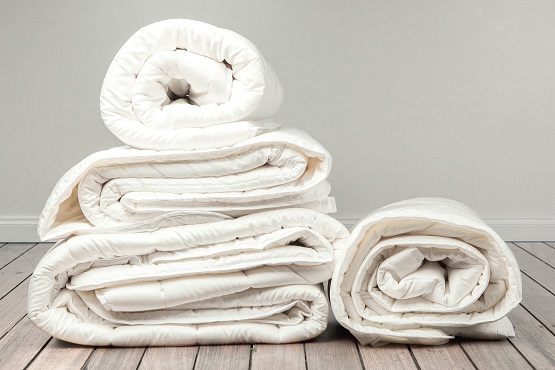

Characteristics & Benefits of Natural Wool
Natural wool is hypoallergenic, warm, and breathable, which makes it perfect for all seasons. Compared with other natural and synthetic fillings, the benefits and advantages of natural wool stand out.
-
Down
Down insulation is made from goose or duck plumage, the lofty, fluffy layer under the feathers. Premier down has superb warmth-to-weight ratio, and high compressibility, and it is often regarded as the crème de la crème of insulator. However, down has its drawback. On one hand, down is inefficient in repelling moisture, and once it gets wet, it is often slow to dry. Thus, down is not an ideal choice for rheumatism sufferers. Also, down will lose much of its insulating property when it gets moist. On the other hand, it is not easy to make down duvets down-proofed, so the amount of down reduces as time goes on.
-
Silk Fibre
Silk fibre is soft and warm, rich in amino acids necessary for human body, and suitable all year round. However, silk fibre has very low breathability, fluffiness and warmth-weight ratio. Just like down, silk fibre is inefficient in repelling moisture, and since it’s a natural biotic fibre, when it gets moist, it becomes a hotbed for bacteria and dust mites. Also, silk fibre is static causing, which could be irritating on dry and warm days. Due to its fragility, silk is not washable and should avoid any exposure to direct sunlight. Thus, silk quilts are not recommended to asthma, allergies, or rheumatism sufferers.
-
Cotton
Cotton is warm, absorbent and breathable. However, cotton is heavy, especially when it gets wet, and is usually not machine-washable.
-
Synthetic Polyester
Synthetic polyester is lightweight and machine washable, but not breathable, static causing, and easy to lose loft and warmth.
-
Lyocell
Lyocell is somewhere in-between natural and synthetic fibres, as it is made from cellulose of wood pulp, which is broken down chemically. Many of its properties are similar to natural cotton, e.g. moisture wicking and breathability, but it may not be an appropriate choice for people with multiple chemical sensitivities.
-
Natural Wool
Natural wool has many beautiful characteristics that make it perfect for all the seasons round and allergy friendly.
-
Breathable & absorbent-Wool
Breathable & absorbent-Wool is hygroscopic, and can easily absorb up to 30% of its weight of moisture without feeling damp or clammy. Wool absorbs perspiration, so that it keeps a layer of dry air next to the skin, helping to retain body heat. Moreover, wool always absorbs moisture from the atmosphere of greater humidity and releases it to the drier environment, so it creates a balance in moisture conditions. As wool absorbs atmospheric moisture, the hydrogen bond of water breaks and chemically reacts with molecules of wool, generating heat. Thus, the breathability and absorbency of wool makes it a good “temperature regulator”, and suitable for both cold and warm weathers.
-
Lightweight-Wool
Lightweight-Wool has a higher warmth-weight ratio than cotton and silk.
-
Durable-Wool
Durable-Wool has high elasticity and flexibility, making it much more durable than other fibres. Wool fibre can be bent back on itself more than 20,000 times without breaking, compared with about 3,000 times for cotton and 2,000 times for silk. Under proper care, wool batting can remain fresh and fluffy for more than 20 years.
-
Retains shape & compressible
Each wool fibre is a molecular coil spring, making it remarkably elastic, so the wool batting can easily return to the original size after being compressed. This characteristic makes wool easier to store than silk and polyester.
-
